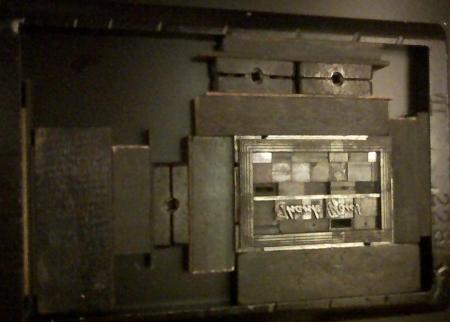printing with borders
Hi Everyone,
I was adventurous and tried printing a simple card with a border. The borders themselves are 24-point foundry type of some age (in a type cabinet I bought last year), in 2-pica and 6-pica lengths.
Results were disappointing. Is it possible to get clean, continuous borders (without the visual separation) from used type? Or will I have to use newly cast borders? The ends were not obvious smashed up, and I locked it up using corner pieces (see photo) and cranked my quoins down.
(The inking was obviously also a problem. But one thing at a time!)
Thanks,
Jason H

thankyou.jpg

lockup3.jpg
Use polymer.
Jason, it is possible to make those borders print without the lines. Or at least minimize it.
If you could get a rectangular sharpening stone like they make for sharpening knives you could clean up the ends, causing them to meet up better.
You could lay the stone on a flat surface, provided it’s about an inch tall, and with the type on it feet on the flat surface as well, you could grind it very lightly against the edge of the stone until it cleans up good. To do it squarely is the key.
You may be able to also use a fine emery cloth against a piece of furniture to achieve the same result. Just go lightly.
It may just be oxidation or other gunk.
If it were me, I might just leave the lines. It gives it that unmistakeable letterpress character and charm.
Your inking is another issue.
Dave
i would use an engravers rubbing stone, if you can find one, they are like a hard eraser, printing borders is not so easy, you will strip the ink off your rollers and struggle with uneven inking. good idea Dave, the knife sharpening stone should work just like the rubbing stone, just go easy with it.
You can also use wet sandpaper and go with 600 grit. If you want ultra fine then 1200 grit will barely take anything off and give you that peace of mind that you aren’t taking too much off.
Hello Jason,
I was having this problem, too. In addition to the suggestions already given, I was advised to use spacing material that was in good condition and very clean on all sides.
Also, I’m thinking that corner pieces should be used on both the outside and inside of the border. Is this correct?
Thanks,
Barbara
Hi
I wouldn’t do anything with the lines. Remember that you often use old vintage or even antique material when you are doing letterpress the traditional way. Please don’t compare the quality of letterpress directly with digital printing or offset - they are more accurate and precise techniques than letterpress but, in my opinion, without any charm. Unless you have acces to the best presses and new types, don’t even compare with industrial letterpress form the time after WW2, where the shops where equipped with modern machinery as Heidelberg, 3M make ready, Linotype, Ludlow etc. etc. Don’t use printed material from the type foundries as reference either!
It’s always difficult to define a quality standard, but I’m using as reference for my work a little collection of prints from old Danish printers who used material like me - small presses and moveable type. Several of the old shops were based, as mine, on second hand types and presses. They did fantastic works and you are able to see that it’s made by the hand - you can see the charming lines between the ornaments and the rules. You can see that some types have som tears and wears - all that you can’t get from a digital form. If a type is 100 years old it’s okay with me if it doesn’t print as a newborn :-)
Gott grüß die Kunst
Jens
I don’t think ol’ Ben was talking about the corners, but “Join, or Die” could have been said about that as well.
One of the original images recently sold at auction for big bucks.
[edit] Of course, this is an anecdotal response.
Nothing wrong with attempting to achieve the best that can be done with what you’ve got.
joinordie.jpg
Specifically… What is that in relation to? (Pardon my poor historical knowledge)
Havenpress,
I’m not American, so my knowledge is a bit shaky. However, I did write a short essay for a class one time about Benjamin Franklin’s printing activities and I believe this political cartoon was done in the 1750s and printed in one of his newspapers. The pieces of the snake represent some of the colonies and the image is suggesting that they stick together.
-Kim
Hi again Jason,
While we’re on the subject, I thought I’d share something that was posted on the Letpress list yesterday. It’s the August 1927 issue of a Monotype journal, which David MacMillan has kindly scanned and added to archive.org. It showcases many border arrangements, and David’s scans are of sufficient resolution such that when magnified you can see clearly how the pieces fit together. The pieces are identified on pages 22 and 23.
But I think that Jens is correct. These layouts are advertisements for the ornamentation, so no doubt every measure was taken to bring them to ideal standards. Still, though, it’s an ideal worth striving for, if only for the learning experience.
Barbara
Thanks Everyone. I’ve sanded the ends of my border pieces a bit and am paying very close attention how adjacent pieces are joining up. I’ll try printing again soon.
Barbara: thank you for the link to the Monotype catalog. If I could set type and print and obtain results as handsome as these, I would be a happy person indeed.
Jason